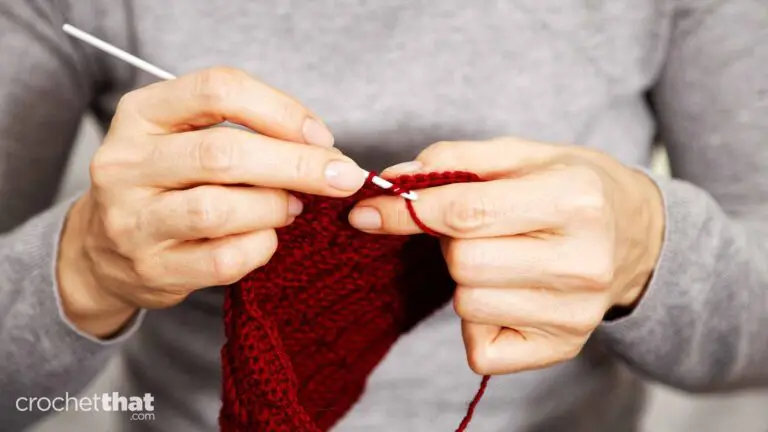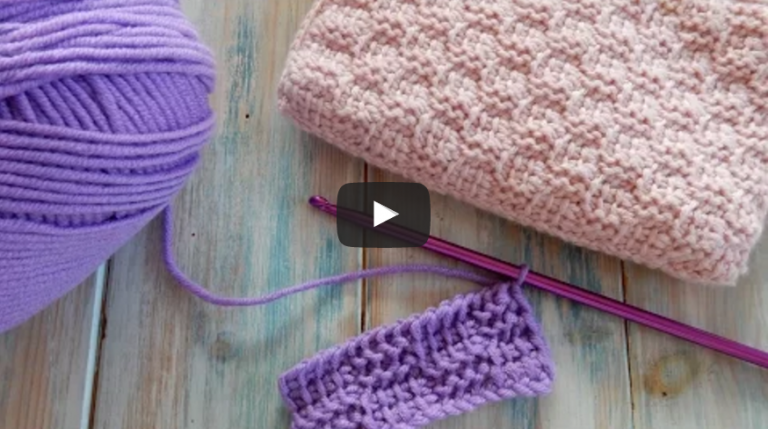Crochet That is supported by our community. When you buy through links on our site, we may earn an affiliate commission.
As an Amazon Associate, Crochet That earns from qualifying purchases.
Crochet is an art form that has been around for centuries. You can crochet almost anything from blankets to clothing and even food! But, there are some things that crochet still can’t do even after all this time – one thing being the ability to be done by a machine. In this blog post we will explore why that’s true, as well as why knitting can be done by a machine, the pros and cons of knitting machines, and what to look for in a good knitting machine.
- Can Crochet Be Done by a Machine?
- Why Can’t Crochet Be Done by a Machine?
- Crochet Machine Alternative
- Why Can Knitting Be Done By Machine if Crocheting Can’t?
- How Do Knitting Machines Work?
- Do you need to know how to knit to use a knitting machine?
- Is knitting by hand better than using a knitting machine?
- Pros of Knitting Machines:
- Cons of Knitting Machines
- Types of Knitting Machines
- What to look for in a good knitting machine
Can Crochet Be Done by a Machine?
Unfortunately, crochet cannot be done by a machine. This means that every crocheted piece you see is made completely by hand. The reason for this is because crochet requires a lot of dexterity and skill. It’s not the same as knitting, which can be done by machine with stitches that are all set in advance on an automated loom or frame – so there isn’t much room to make mistakes when you’re using machines like these!
Why Can’t Crochet Be Done by a Machine?
While knitting machines have been around since the 1800’s and are highly popular because they produce large quantities of knitted fabric, crochet cannot be replicated by a machine. These machines may be able to replicate the loops on a loom for weaving fabric or knitting, but they lack the ability to create intricate stitches like those in crochet.
The reason why this is so hard for these machines to do is because crocheting requires more than just making loops with yarn – you also need to pull each loop through another loop at the same time! This process does not lend itself well to automated production methods which use needles or hooks, and it’s difficult for a machine to replicate the dexterity needed to do this while maintaining the proper stitch tension.
Crochet Machine Alternative
While there may not be a crochet machine, a knitting machine is likely close to what you’re looking for and will probably create what you want. You can use it to create a variety of projects quickly and easily, making it a great way to crank out some quick gifts for friends and family!
Why Can Knitting Be Done By Machine if Crocheting Can’t?
Knitting can be done by machine because the entirety of a knit item has a live edge vs a single live stitch on a crocheted piece. When you knit, the loops of yarn are always connected to each other. This means that when a loop is pulled through another one on your needle or knitting machine shuttle it’s done so in such as way where there will be an open stitch at both ends and no live stitches leftover – this makes for easy automated production!
How Do Knitting Machines Work?
Knitting machines work by using a needle that has an attached hook at the end. The machine will pull loops of yarn through each other and then onto this hooked device, which is called “the knitting carriage.”
The knitting carriage can be set up in a variety of ways, depending on the type and size project being made: flat (like with blankets) or circularly like when making sweaters! The user also has control over how tight they want their stitches by adjusting the tension on the knitting carriage.
The needles are set up in pairs so they can work together to produce stitches on both sides simultaneously – one side produces knit stitch while another creates purl ones!
A machine can be used to make a variety of projects, including sweaters and blankets! Knitting machines are also great for making hats because they’re able use circular needles that allow you knit in both directions – something traditional hand-knitters cannot do without switching their work around mid project or using two sets of needles.
Do you need to know how to knit to use a knitting machine?
No, you don’t need to know how knit in order to use a knitting machine. All the user needs is yarn and needles! While it’s not necessary that they already be skilled at knitting before using a knitting machine, there are some benefits of knowing what stitches look like before using one. Because all machines use needle pairs with different functions (knit stitch and purl stitch), it’s helpful to know which needle is for which type of stitch.
Is knitting by hand better than using a knitting machine?
Knitting by hand isn’t necessarily better than using a knitting machine depending on the project you’re trying to make. Knitting machines are a great tool for knitters who want to produce large quantities of the same item without having their hands cramp up from all that hand-knitted work. They’re also useful in situations where it’s difficult or impossible (due to injury, age) to do traditional knitting by holding needles and yarn with your fingers. Knitting machines are also great for knitters who have a hard time with tension, which is the tightness of the stitches.
Machine knitting has its drawbacks, too. The most obvious is that the machine does all of your work for you – so if there’s a mistake in what it produces or something goes wrong with how tight one row was knitted compared to another (a common problem), then fixing those mistakes can be difficult and time-consuming on top off having to do the work in question.
Knitting by hand means you can produce a wider variety of items than most consumer knitting machines can make. Most knitters also simply enjoy the activity of hand knitting, and find it a relaxing hobby. It’s also difficult to beat the love poured into a hand-knit gift!
Pros of Knitting Machines:
- Knitting machines are a time saver, and can produce many items in less than an hour.
- Knitting machines don’t require as much skill to use them correctly as knitting things by hand (though they do take some getting used too).
- Knitting machines are easier on your hands, which make them great for people who suffer from arthritis or other hand-related illnesses or disabilities.
- Knitting machines have a very low cost of entry, and can be used for many different projects with minimal investment in yarns (though you will still need to buy the machine).
- You don’t really have to worry about uneven stitch tension when using a knitting machine.
Cons of Knitting Machines
- Knitted items made on a machine are often less durable than hand-knit ones.
- The stitches can also be tighter and more uniform, which is great for some projects but not others (like sweaters).
- It’s difficult to make certain shapes with knitting machines that you could easily do by using your hands to knit.
- It can be difficult to catch mistakes while knitting with a machine, which can lead to more mistakes in the finished product.
- It takes a lot of time and practice before you’re able to create anything that looks like it was made by hand, so knitting machines are not an ideal solution if your goal is quality over speed or quantity (though they do make good projects when done right).
Types of Knitting Machines
It may surprise you to learn that there is more than one type of knitting machine. In fact, there are 4 common types of knitting machines: knitting looms, flatbed knitting machines, circular knitting machines, and automated commercial knitting machines.
Knitting Looms
Knitting looms are the oldest type of knitting machine. They were first invented in the 16th century by William Lee of Calverton. The machine was so revolutionary, he demonstrated it before Queen Elizabeth I.
A knitting loom has needles with hooks on them so when one row has been completed you just pull down each hook along its length until there isn’t any slack left between rows. This makes sure everything stays tight together while still keeping up speed without sacrificing quality.
Flatbed Knitting Machines
Another type of knitting machine is a flatbed knitting machine. Flatbed knitting machines are the most common type of machine and they’re also usually cheaper than other types. They can produce more items in a shorter amount time, which is great for businesses that need to make large quantities quickly or cheaply (think about how many sweaters you could churn out with one!).
The flat pieces produced by these devices have less chance at stretching after being sewn together because there’s no shaping involved-it just goes straight from skein form into garment shape without any changes along its way through production!
Flatbed knitting maches are more complicated than looms and require the knitter to do all sorts of calculations in order for them to work properly. As the name implies, you’re only able to produce flat pieces on this, meaning that if your item needs multiple pieces, it will have seams along the side.
Circular Knitting Machines
The next type of knitting machine is a circular knitting machine. Circular knitting machines are the type that is used to make hats or anything else that benefits from being worked in the round. These machines are a lot like flatbed knitting machines, but instead of making one long piece, they work in rounds so you can keep adding on yarn as needed for larger projects.
Circular knitting machines are not very good at producing seams in the fabric so you’ll need to be careful when sewing together your finished project if it has a seam that’s noticeable on both sides of an item (like socks). This is because there will always have two rows where one row overlaps another which can make seaming difficult or impossible depending upon what type of material was used with these types of knitting machine stitches.
There are many small, beginner circular knitting machines that are an affordable way to try machine knitting to see if it’s right for you. Hats made on a circular knitting machine also make quick, affordable gifts!
Automated Commercial Knitting Machines
The fourth kind of knitting machine is the large, automated, commercial knitting machine. They’re basically like flatbeds, except instead it’s just one needle going up-and-down by itself. This means less human involvement which cuts production costs significantly (though not without drawbacks). This type of knitting machine will produce low-cost items quickly while still being able to use high-end materials because its needles don’t need any help from humans at every step.
What to look for in a good knitting machine
When shopping for a knitting machine, you should look at a few things. The first thing you should check is the number of needles it has. The more the better, but you’ll have to pay for them and they will take up a lot less space than if there were fewer on board.
Another thing to look at is how much yarn can be loaded at once. This is important because when your project gets big (or even just starts getting bigger) then this becomes an issue that needs addressing sooner rather later!
Finally, you should check the speed of your machine. This is important because if it’s too slow then that will mean a lot more time spent on projects and less done in general!





